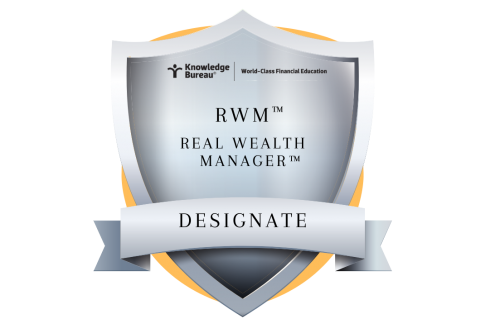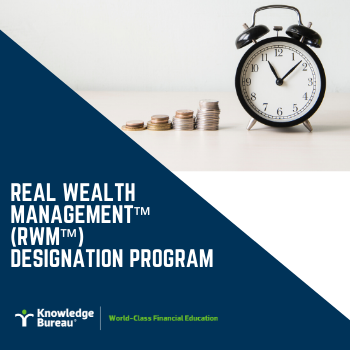Last updated: September 15 2021
Exclusive: A Comprehensive Approach to Wealth Management

Many ultra-high net worth families have implemented a ‘family office” to focus on a collaborative and holistic approach to their wealth management. Famous examples include the DuPont, J.P. Morgan and Rockefeller Families. Now, this concept is democratized in the new Real Wealth Management™ Designation Program. Available this month, the new program brings required technical expertise, new conversation guides and a consistent practice management framework to formulate a strategic plan like minded professionals can work cohesively with as part of a client’s “outsourced” family office.
Excerpts from the Real Wealth Management™ Designation Program:
Wikipedia defines a family office to be “a privately held company…with the goal being to effectively grow and transfer wealth across generations.”
In recent years we have seen a growth in the number of family offices. The Global Family Office Report 2019 by UBS and Campden Wealth notes that 68 percent of the Family Offices surveyed were founded in 2000 or later. Credit Suisse estimates that there may be between 6,500 to 10,500 family offices globally.
In addition, family offices may be able to operate at a lower cost than traditional vehicles. Historically financial institutions may have charged the family significant managements fees. A family office allows those investments decisions to be brought in house potentially resulting in lower fees.
The Global Family Office Report 2019 showed that the 360 family offices surveyed paid an average of 117 basis point (1.17%) in total costs, including all operational, administrative, and performance-related costs. The reduction of fees is one of the goals of a Real Wealth Manager, RWM™.
Depending on the family’s particular needs and objectives, the family office may assist in:
- Investing and managing the financial portfolio
- Property management
- Implementing and assisting with the family business
- Managing the family’s philanthropic interests
- Managing household staff
- Making travel arrangements

- Succession planning, etc.
In determining whether a family should consider a family office there are three questions that should be addressed:
- The size of the family’s wealth
- The complexity of the family’s life, in particular the Chief Family Influencer (CFI) defined, below
- The priorities of the family
Depending on the family’s wealth and needs the “family office” may be:
- A dedicated single member “traditional” family office. Forbes magazine estimates that the most quoted figure, in terms on when a traditional family office is viable and cost-efficient, is in the range of $100 million to $250 million in liquid assets.
- Multi-family offices. Rather than go it alone, some families will combine resources and create a mulit-family office which will serve the needs of all the families involved. In addition, independent firms have also been established to perform most of the functions of a typical traditional family office. A fee is usually charged. Some examples of independent multi-family office firms are KPMG. PWC, Deloitte, amongst others. Because resources are shared, a multi-family office does not provide the same level of control that a traditional family office would.
- The “outsourced” family office. This is not an office at all or a single entity or structure. It is a collaborative effort among numerous supporting advisors. Creating such a “family office” lacks the total control or coordination that a traditional family office would have but it is the least expensive approach. It is in this latter framework that a RWM™ would thrive, bringing their skills to provide a holistic and comprehensive approach to their clients needs. An RWM may be the linchpin in creating an effective “outsourced” family office for their clients’ needs.
Be sure to enrol before September 30 to receive a $100 reduction in the tuition fees for this excellent program which has been enhanced in its new edition to include 15 critical chapters:
PART A: RWM Strategy
- Module 1 | Defining Real Wealth Management
- Module 2 | The Strategic Approach in Real Wealth Management
- Module 3 | The RWM Process
- Module 4 | The Costs of Building Wealth
PART B: RWM Process
- Module 5 | Accumulation
- Module 6 | Growth
- Module 7 | Preservation
- Module 8 | Transition
- Module 9 | Objective-Based Family Planning
PART C: RWM Theory: The Tax Backdrop
- Module 10| Tax Strategies:Managing Sources of Income and Capital
- Module 11| Cross-Border Issues - Canadians and US Investments
- Module 12|Start Ups:Incorporated or Unincorporated
- Module 13| CCPC Planning - Understanding Shareholder Equity (Corporate Fundamentals)
- Module 14| CCPC Planning – Shareholder Remuneration (Incorporated Pros)
PART D: RWM: Practice Management
- Module 15 | Leading the Real Wealth Management Strategy
- Module 16 | Sharing the Plan with Inter-Advisory Stakeholders
- Module 17 | Analysis, Accountability and Go Forward Planning
- Module 18 |You, the Real Wealth Manager
“I was surprised at how well the course was structured, it sets you up for success. Loved it! It was a wonderful revitalization of the value that we are bringing to our clients.”
- Doug Buss, RWM™
